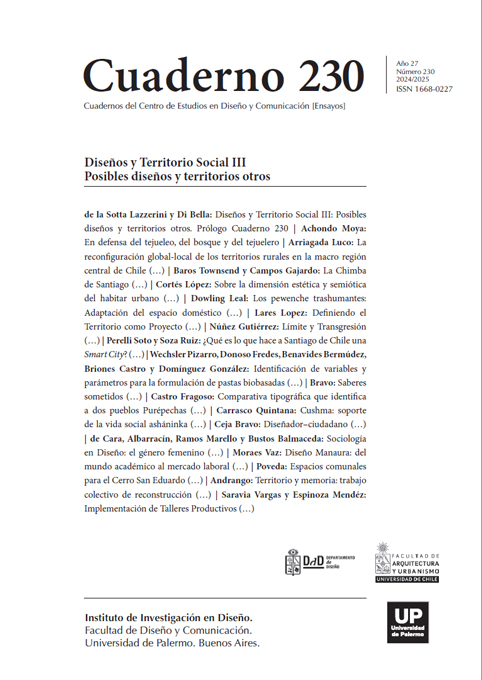¿Qué es lo que hace a Santiago de Chile una Smart City? Dos perspectivas
Resumo
Este capítulo aborda a transição de Santiago do Chile para o paradigma da Cidade Inteligente, explorando as dimensões de cima para baixo e de baixo para cima desse processo.
Referências
Capdevila, I., & Zarlenga, M. I. (2015). Smart City or Smart Citizens? The Barcelona Case. SSRN Electronic Journal. https://doi.org/10.2139/ssrn.2585682
Cordeiro, A. V., & Beiguelman, G. (2015). Smart city and Internet of Things: Possible changes in the public space. In Computer-Aided Architectural Design Futures. The Next City-New Technologies and the Future of the Built Environment: 16th International Conference, CAAD Futures (pp. 8-10).
Correa, J., Felipe Ulloa-Leon, Francisco Vergara-Perucich, Carlos Aguirre-Nuñez, & Ricardo Truffello. (2023). Infrastructural inequality: exploring the emergence of digital classes in the Metropolitan Area of Santiago, Chile. Bulletin of Geography. Socio-Economic Series, 62, 107–122. https://doi.org/10.12775/bgss-2023-0037
González, J. A. A., Rossi, A. (2011). New trends for smart cities. Opencities, Manchester. Caroline Haythornthwaite (2005) Social networks and Internet connectivity effects, Information, Communication & Society, 8:2, 125-147, DOI: 10.1080/13691180500146185
Kirimtat, A., Krejcar, O., Kertesz, A., & Tasgetiren, M. F. (2020). Future Trends and Current State of Smart City Concepts: A Survey. IEEE Access, 8, 86448–86467. https://doi.org/10.1109/access.2020.2992441
Kummitha, R. K. R. (2020). Smart technologies for fighting pandemics: The techno- and human- driven approaches in controlling the virus transmission. Government Information Quarterly, 101481. https://doi.org/10.1016/j.giq.2020.101481
Kummitha, R. K. R. (2020). Why distance matters: The relatedness between technology development and its appropriation in smart cities. Technological Forecasting and Social Change, 157, 120087. https://doi.org/10.1016/j.techfore.2020.120087
Kummitha, R. K. R., & Crutzen, N. (2017). How do we understand smart cities? An evolutionary perspective. Cities, 67, 43–52. https://doi.org/10.1016/j.cities.2017.04.010
Markopoulou, A. (2020). Smart who? collective intelligence urban design models. Architectural Design, 90(3), 122-127.
Mitchell, W. J. (1999). E-topia: Urban Life, Jim But Not As We Know It. MIT press.
Mora, L., Deakin, M., & Reid, A. (2019). Combining co-citation clustering and text-based analysis to reveal the main development paths of smart cities. Technological Forecasting and Social Change, 142, 56–69. https://doi.org/10.1016/j.techfore.2018.07.019
Motion, C. I. (2022). Índice IESE Cities in Motion 2022. https://www.iese.edu/media/research/pdfs/ST-0633.pdf
Neirotti, P., de Marco, A., Cagliano, A. C., Mangano, G., & Scorrano, F. (2014). Current trends in Smart City initiatives: Some stylised facts. Cities, 38, 25–36. https://doi.org/10.1016/j.cities.2013.12.010
Ojo, A., Dzhusupova, Z., Curry, E. (2016). Exploring the nature of the smart cities research landscape. In Smarter as the new urban agenda (pp. 23-47). Springer.
Orellana, A. (Ed.). (2023). Índice De Calidad De Vida Urbana (ICVU) 2022 (1st ed.).
Picon, A. (2015). Smart cities: a spatialised intelligence. John Wiley & Sons.
Pinto, F., Ferreira da Silva, C., & Moro, S. (2022). People-centered distributed ledger technology-IoT architectures: A systematic literature review. Telematics and Informatics, 70,101812. https://doi.org/10.1016/j.tele.2022.101812
Rogers, Everett M. (1962). Diffusion of innovations (1st ed.). New York: Free Press of Glencoe.
Sabatier, P. A. (1986). Top-Down and Bottom-Up Approaches to Implementation Research: A Critical Analysis and Suggested Synthesis. Journal of Public Policy, 6(01), 21–48.
Silva, B. N., Khan, M., & Han, K. (2018). Towards sustainable smart cities: A review of trends, architectures, components, and open challenges in smart cities. Sustainable Cities and Society, 38, 697–713. https://doi.org/10.1016/j.scs.2018.01.053
Soza Ruiz, P., Perelli Soto, B., & Tapia Zarricueta, R. (2021). Smart cities, smart housing, smart habitat: are we there yet? Blucher Design Proceedings, 1127–1138. https://doi.org/10.5151/sigradi2021-373
SUBTEL. (2020). Zonas de baja conectividad.
SUBTEL. (2021). Antenas en Servicio Ley de Torres. http://antenas.subtel.cl/LeyDeTorres/ informacion
Zallio, M., Berry, D., & Casiddu, N. (2016, December). Adaptive environments for enabling senior citizens: An holistic assessment tool for housing design and IoT-based technologies. In 2016 IEEE 3rd World Forum on Internet of Things (WF-IoT) (pp. 419-424). IEEE.
Los autores/as que publiquen en esta revista ceden los derechos de autor y de publicación a "Cuadernos del Centro de Estudios de Diseño y Comunicación", Aceptando el registro de su trabajo bajo una licencia de atribución de Creative Commons, que permite a terceros utilizar lo publicado siempre que de el crédito pertinente a los autores y a esta revista.


